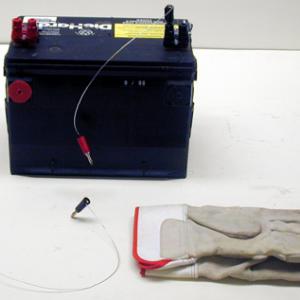College of Liberal Arts & Sciences
5F15.33 - Fuse Wire
A demonstration of a fuse is to take a length of the soft wire that is available and short directly across the 12 volt car battery. The wire will heat to a glowing red before it melts breaking the circuit.
NOTE: The wire should be bent so that when it melts it does not fall on the instructors hands.
- Serge Florens, "Investigating SWG Values", TPT, Vol. 51, # 4, April 2013, p. 198.
- William Layton, "The Fuse-Wires-in-Parallel Problem", TPT, Vol. 51, # 1, Jan. 2013, p. 38.
- Tik Liem, "The Aluminum Foil Fuse", Investigation to Science Inquiry, p. 256.
- Tik Liem, "The Balloon Fuse", Investigation to Science Inquiry, p. 257.
- "Short Circuit", Exploratorium Science Snackbook, p. 86.1 - 86.2.
- "Cool Hot Rod: Short Circuit", Exploratorium Science Snackbook, p. 89.
- Ron Hipschman, "Short Circuit", Exploratorium Cookbook III, p. 151.1 - 151.4.
- Grant Mellor, "Blowing a Fuse", Flying Tinsel, 1993, p. 88-90.
- Rudolf F. Graf, "Electricity Can Produce Heat and Light", Safe and Simple Electrical Experiments, p. 79.
- Rudolf F. Graf, "Let's Make a Fuse", Safe and Simple Electrical Experiments, p. 85.
Disclaimer: These demonstrations are provided only for illustrative use by persons affiliated with The University of Iowa and only under the direction of a trained instructor or physicist. The University of Iowa is not responsible for demonstrations performed by those using their own equipment or who choose to use this reference material for their own purpose. The demonstrations included here are within the public domain and can be found in materials contained in libraries, bookstores, and through electronic sources. Performing all or any portion of any of these demonstrations, with or without revisions not depicted here entails inherent risks. These risks include, without limitation, bodily injury (and possibly death), including risks to health that may be temporary or permanent and that may exacerbate a pre-existing medical condition; and property loss or damage. Anyone performing any part of these demonstrations, even with revisions, knowingly and voluntarily assumes all risks associated with them.
